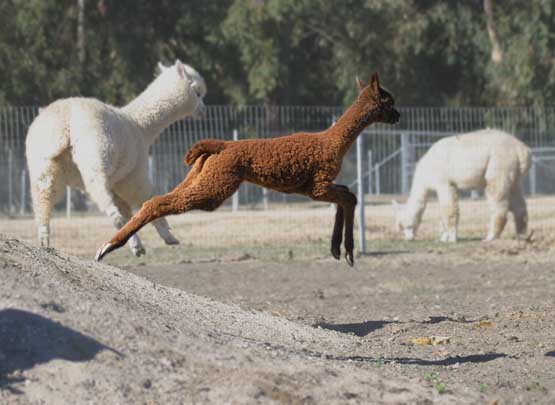|
Silver Thunder
Alpacas presents:
Alpaca Questions Answered
The
best way to learn about alpacas is to come see them in person. That's
how we learned - by hanging out at different ranches and asking lots
of questions. So consider yourself invited. We'd love to have you come
visit our alpacas and learn for yourself. There's no better way to get
an education.
Please feel free to call or email and we'll be glad to arrange a visit
at a time that suits you best. C'mon over. You'll have a great time.
So
what is an alpaca?
Alpacas
are long-necked fur-bearing creatures raised for their warm and luxurious
fleece. Members of the camel family, they come from South America where
they have existed for thousands of years. Believed to be among the first
animals ever domesticated by man, they have been bred and raised for
the past six thousand years by the Incas and their descendants.
Residing
high in the Alti Plano, the cold and dry plains far up in the Andes
Mountains of Peru, Chile and Bolivia, the alpacas have adapted to the
cold weather at fourteen thousand feet elevation. Which helps to explain
why their fur is so thick and warm.
What
are alpacas used for?
Alpacas
are sheared once a year, like sheep. Shearing usually occurs in late
spring, giving the alpacas time to regrow their fleece before the next
winter while also keeping them cooler during the hot summer months.
The sheared fiber is then processed in mills or by hand to create high-end
woven products including clothing, blankets and household goods.
Alpaca
fiber is warmer than wool, softer than wool, lighter than wool, stronger
than wool, not itchey like wool, contains no lanolin, and is hypo-alergenic. As soft as cashmere but more durable. Very strong, yet very soft. A truly luxurious
fiber.
Alpaca
fiber comes in many natural colors. There are twenty-two distinct shades
of whites, greys, browns and blacks. These colors will never fade, as
they are built into the fiber at the cellular level. (The same way that
your own hair fades very little if you stand around in the sun.) In
addition, white fleece can become whatever color one desires, as the
fibers may be dyed to any shade imaginable.
How
long have alpacas been in this country?
Alpacas
were first imported into the United States in 1984. For more than twenty
years, breeders have been carefully making choices on which animals
to breed in order to continually improve the North American herd. In
1998 it was decided that there was sufficient breeding stock in the
United States to be able to close off further importation from South
America. Currently the only animals able to be registered in this country
are those that have been born here.
Registration
is an important part of alpaca ownership. Each North American alpaca
is registered with the Alpaca Registry (known as ARI). A blood sample
is tested by DNA analysis in order to prove the precise parentage of
every animal. Registration papers will show the entire family tree of
each alpaca, back as far as possible to the first imported relatives.
So the ancestry of each animal is a proven and known entity.
What
are the two kinds of alpacas?
Alpacas
come in two flavors, each with a funny South American name: Huacayas
and Suris. These are based on the way the fiber grows on the animal.
The
Huacaya (pronounced "wha-KAI-uh") has a fuzzy teddy-bear-like
coat with tightly bunched curls that makes for a somewhat fluffy appearance.
The
Suri (pronounced "SIR-ree") has lengthy flowing fiber that
hangs down the side in long silky strings, the locks appearing somewhat
like Rastafarian dreadlocks.
Huacayas
and Suris both come in all the many colors that alpacas come in. The
primary difference is the appearance of the fiber. Because the fiber
structure is so different, alpaca shows hold separate judging for the
two alpaca types.
Is
one kind better than the other? No, It just comes down to personal preference
as to which kind of alpaca one finds appealing. Thus far, Silver Thunder
Alpacas has chosen to concentrate solely on Huacaya alpacas.
Alpaca Factas
Alpacas
come from South America where they live in the dry high country called
the Alti Plano at elevations up to 14,000 feet.
Alpacas
are members of the Camel family, what veterinarians call "camelids".
Other South American Camelids include the Llama, the Guanaco and the
Vicuna.
There
are six million alpacas in South America, three million in Peru alone. Mostly white. They breed
for white to make it easier to dye the fiber later with bright colors.
In
North America alpaca breeders often breed for colored alpacas because
hand spinners, weavers and fiber artists prefer the many beautiful shades of fiber available in
natural colors.
Alpacas come in 22 distinct colors. Shades of black, grey, brown, tan, red, gold, and white. (In the show ring the alpacas are classed into 16 different colors to simplify judging decisions.)
In
the United States there are currently more than 100,000 registered alpacas
living on 4,000 farms and ranches that are found throughout all fifty
states.
Nearly all alpacas in the United States are registered. A blood sample from each alpaca is sent in for DNA testing to verify correct parentage and ownership.
Every registered alpaca has registration papers showing it's entire geneology all the way back to the point of importation into the United States.
Because every alpaca is registered, a stolen alpaca in not sellable, as an alpaca without registration papers has no value. Also, a stolen alpaca is easily traceable as it's DNA-tested blood becomes it's "license plate" to trace ownership and prosecute theft.
Alpaca
fiber is warmer than wool, softer than wool, lighter than wool, stronger
than wool, not itchey like wool, and non-alergenic. A truly luxurious
fiber.
Baby
alpacas, called crias ("CREE-uhz"), love to run and jump and
play. That's our Gingerbread as a cria in the photo at the top of this page.
It takes nearly a whole year to make a baby. The gestation period for alpacas is 11 1/2 months.
Alpacas are herd animals and depend on the group for their safety and contentment. If one rolls for a dustbath, others will follow. If one goes to the poop-pile (they all go in one place), others will get in line too.
Alpacas are very curious animals, always inquisitive about the world around them. They will lean over the fence to inspect something new, such as a new cria in the next pen.
Curious alpacas will lift their heads to inspect an approaching car coming down the driveway and (at least at our farm) come to the fence hoping for a baby-carrot snack from the new visitors.
Alpacas will make an alert sound if they sense danger. (It sounds like a cross between a donkey and a parrot. A very distinctive and loud "eee - eee - eeeeeh" sound.) One alpaca will sound the alert, and the whole herd will look up to see what they are alerting at. The perceived threat might not be actually dangerous, sometimes its just something new that they haven't seen before.
Always
adding to this list of short alpaca facts. Please stay tuned.
Thanks again for
visiting,
Chuck and Nancy
Silver
Thunder Alpacas
Making
great alpacas in Greeneville,
Tennessee
Pure
Bred and Hand Fed!
Click here to return
to the top of this page: Alpaca
Facts.
Click here to return
to the Silver Thunder
Home Page. Or just click on the Silver Thunder logo in
the top left corner of any page on this site to return to the home page.
 Proud to be an
American. Proud to be an
American.
This
page last updated 12/23/08
|











